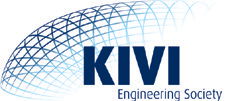 Since 1 February 2017 the DBM chair is supported by KIVI and has become a KIVI chair. The background and associated activities will be described below.
Since 1 February 2017 the DBM chair is supported by KIVI and has become a KIVI chair. The background and associated activities will be described below.
BACKGROUND
The KIVI chair aims to bridge the gap between academic research and industrial practice in maintenance related topics. We will therefore deploy activities that assist to (i) share the knowledge that is created at the university, and (ii) to guide the academic research by actual problems and challenges from industry.

BRAINSTORM SESSIONS
On a regular basis (several times a year) we will organize a brainstorm session on a specific topic with a small number of selected companies. The procedure for this is as follows:
- Companies are invited to provide us with their maintenance related problems or challenges. This should preferably be technical issues (e.g. sensors, monitoring, specific failures, data analysis), but could also be more business related aspects (e.g. decision support, expert systems, asset management, business case, logistics).
An application form can be found at the bottom of this page. - Several times a year we select a number of related challenges and invite the companies for a brainstorm session (1/2 to 1 day). From the university side, staff members, researchers and students will take part in the session.
- The outcome of the brainstorm session can be two-fold:
- The problem has been solved during the session, or at least a direction for solving the issue could be identified. In this case the companie(s) can start implementing this solution;
- After the session it is concluded that certain technology or procedures have to be developed. In that case, the university will try to set-up a research project in which this knowledge can be developed;
- The generic results of the brainstorm session will be published on our website to inspire other companies with similar problems.
In this way, companies will be assisted in solving their maintenance challenges, while at the same time the research chair gets insight in missing knowledge and technology in practice, which can be used to guide future research.

